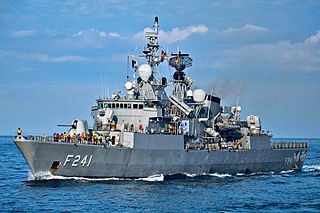
The Oliver Hazard Perry class is a class of guided-missile frigates named after the U.S. Commodore Oliver Hazard Perry, the hero of the naval Battle of Lake Erie. Also known as the Perry or FFG-7 class, the warships were designed in the United States in the mid-1970s as general-purpose escort vessels inexpensive enough to be bought in large numbers to replace World War II-era destroyers and complement 1960s-era Knox-class frigates. In Admiral Elmo Zumwalt's "high low fleet plan", the FFG-7s were the low capability ships with the Spruance-class destroyers serving as the high capability ships. Intended to protect amphibious landing forces, supply and replenishment groups, and merchant convoys from aircraft and submarines. They were also later part of battleship-centred surface action groups and aircraft carrier battle groups/strike groups. Fifty-five ships were built in the United States: 51 for the United States Navy and four for the Royal Australian Navy (RAN). In addition, eight were built in Taiwan, six in Spain, and two in Australia for their navies. Former U.S. Navy warships of this class have been sold or donated to the navies of Bahrain, Egypt, Poland, Pakistan, Taiwan, and Turkey.

The Valour class is a class of frigates built for the South African Navy. Part of the MEKO family of warships, the German shipbuilder Blohm+Voss officially designate the class as the MEKO A-200SAN.

The MEKO family of warships was developed by the German company Blohm+Voss. MEKO is a registered trademark. The portmanteau stands for "Mehrzweck-Kombination". It is a concept in modern naval shipbuilding based on modularity of armament, electronics and other equipment, aiming at ease of maintenance and cost reduction.

The Turkish Naval Forces, or Turkish Navy is the naval warfare service branch of the Turkish Armed Forces.

The 127 mm (5")/54 caliber lightweight gun is a U.S. naval artillery gun mount consisting of a 127 mm (5 in) L54 Mark 19 gun on the Mark 45 mount. It was designed and built by United Defense, a company later acquired by BAE Systems Land & Armaments, which continued manufacture.

The Vasco da Gama class is a class of frigates of the Portuguese Navy. Named in honor of the Portuguese explorer Vasco da Gama, the ships are based on the German MEKO 200 design, and are Portugal's major surface ships. Portugal operates three ships of this class, which were built in Hamburg by Blohm + Voss (B&V) and by Howaldtswerke-Deutsche Werft (HDW) in Kiel, using modular construction techniques.

The G class is one of the frigate classes of the Turkish Navy. They are extensively modernized versions of ex- Oliver Hazard Perry-class guided-missile frigates of the US Navy, mainly designed for air defense with a weapons configuration that is optimized for general warfare.

The MEKO 200 is a frigate design by the Blohm + Voss shipyard of Germany, as part of the MEKO family of warships.

The Yavuz class are a group of four frigates that were built for the Turkish Navy. They were designed in Germany and are part of the MEKO family of modular warships; in this case the MEKO 200 design. An order for ships was signed by the Turkish government in April 1983 for four MEKO frigates.Two ships were built in Germany and two in Turkey with German assistance. They are similar in design to the larger Barbaros-class frigates of the Turkish Navy, which are improved versions of the Yavuz-class frigate.

The Barbaros-class frigates are among the most modern frigates in the Turkish Navy. They were designed in Germany and are part of the MEKO group of modular warships, in this case the MEKO 200 design. Two ships were built in Germany and two in Turkey with German assistance. They are larger than the previous Yavuz-class frigates and are also faster due to using CODOG machinery rather than pure diesels.

The Hydra class are a group of four frigates in service with the Hellenic Navy. They were designed in Germany and are part of the MEKO group of modular warships, in this case the MEKO 200 design.

Gölcük Naval Shipyard is a naval shipyard of the Turkish Navy within the Gölcük Naval Base on the east coast of the Sea of Marmara in Gölcük, Kocaeli. Established in 1926, the shipyard serves for the building and the maintenance of military vessels. A total of 3,221 personnel are employed at the shipyard stretching over an area of 255,526 m2 (2,750,460 sq ft) with covered structures of 121,466 m2 (1,307,450 sq ft).

The Ada class is a class of anti-submarine corvettes developed primarily for the Turkish Navy during the first stage of the MILGEM project. The Turkish Navy has commissioned all four Ada-class corvettes.

TCG Barbaros(F-244) is the lead ship of Barbaros-class frigate of the Turkish Navy.
TCG Salihreis(F-246) is a Barbaros-class frigate of the Turkish Navy.
TCG Kemalreis(F-247) is a Barbaros-class frigate of the Turkish Navy.

TCG Turgutreis(F-241) is a Yavuz-class frigate of the Turkish Navy.

TCG Fatih(F-242) is a Yavuz-class frigate of the Turkish Navy.

TCG Yıldırım(F-243) is a Yavuz-class frigate of the Turkish Navy.























